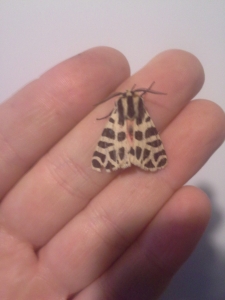Part of the “woolly bear” caterpillar family, Garden Tiger Moth larvae are densely covered in hairs that vary from black on the top of their body to reddish brown along the lower portion. They do not have the banded appearance of their well-known relative the Banded Woolley Bear. Caution should be used when handling caterpillars of this species as the hairs that cover their body can act as a skin irritant. The caterpillars feed on various hibiscus and other non-woody plants. Damage to gardens at times can be significant. Garden Tiger Moths spend their winter as a larval stage finding hiding places along the ground. They pupate the following year from June to July with the moths hatching from July to August in which breeding promptly begins and eggs are laid. Caterpillars hatch in August therefore; this is often the time of heaviest activity for damage to plants cause by this species. Some garden favorites include honeysuckle, raspberry and blackberry although may other plants are consumed as well. Adult Garden Tiger Moths have a fury body with chocolate patches on their fore wings surrounded by cream to white boarders. Their hind wings are a red to orange in color and are used to warn predators of their foul taste and the toxins contained within their bodies. The fore wings help to provide camouflage when they are on the ground. Wing patterns vary greatly and no two are the same, much like a snowflake. Wing span of the adults ranges from 1.8 to just over 2.5 inches depending on the species. In portions of Europe, the Garden Tiger Moth population has decreased by an estimated 89% in the past three decades, which has resulted in the species becoming protected in some areas.
